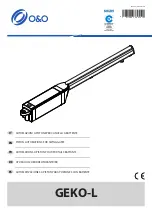
Important Safety Information
S-2
Rev:
A
• Before attaching the operator to the gate, slide the gate in both directions. Make sure it is level and moves
freely. A gate that slides easily reduces strain on operator components. Gravity should play no part in the
opening or closing of the gate.
• In the case of hydraulic operators, never over-tighten a clutch or pressure relief valve to compensate for a
stiff or damaged gate.
• Make sure all exposed pinch points, rollers and wheels are guarded.
• To reduce the risk of entrapment throughout the entire travel path, make sure the gate is installed in a
location so enough clearance is supplied between the gate and adjacent structures when opening or
closing. Minimize the parallel gap between the gate and the fence.
• Make sure a separate walk-through entrance is nearby. Make certain a clear pedestrian path is designated
and signs direct pedestrians to the walk-through gate. The automated gate entry is for vehicle use only. No
one should cross the path of a moving gate.
• Install the gate operator on the secure (non-public) side of the gate. Locate controls (Open, Close, Stop/
Reset) where a user will have a clear view of the gate.
• Mount access control devices beyond reach of the gate. The control devices that operate the gate must be:
→
Located in clear line of site to the gate.
→
Mounted beyond 6 feet (183cm) of the gate, to prevent users from touching or accessing the gate
while operating the controls. People attempting to access the controls by reaching through or
around the gate can be seriously injured or killed by the moving gate.
→
Incorporate a security feature to prevent unauthorized use.
• The gate operator must be properly grounded and the incoming power voltage must match the voltage
label on the junction box.
• Install enough external entrapment protection sensors so that pedestrians are protected from entrapment
in both directions of the gate travel and all hazard areas and possible pinch points are fully protected.
Review the information found in
Secondary Entrapment Protection Sensors
.
• Install the supplied WARNING signs on the inside and outside of the gate so they are clearly visible from
both sides of the gate. Installing the signs is a requirement for UL 325 compliance.
• Connect radio and other remote access (non-resetting controls) to the RADIO OPTIONS terminals.
• Open and close the gate to confirm that it was properly installed and to ensure reduced risk of
entrapment. Verify the clearance between the gate and adjacent structures per UL 325 Safety Standards.
Have a qualified gate technician test the gate monthly.
• When you complete the installation, show the end user how to:
→
Remove the cover. Turn the power off and on to demonstrate relearn limits after DC/AC cycles.
→
Turn the DC power switch off, which disengages the motor, and manually push the gate.
→
Use the Emergency Stop Button located on the side of the control box. It can be accessed
through a hole in the cover.
NOTE
Gate operator instructions must be given to the owner per UL 325 Safety Standards.












































